Thirteen - Trinadtzat' - Тринадцать
1929 - 1931, Member List
The Thirteen movement is another vivid example of the numerous artistic groups organized all along the second decade of the 20th century, existing simultaneously or replacing one another.
In 1929, a group of young VKhUTEMAS graduates calling named ROST Society of Artists has held an exhibition of their work. This exhibition was noted by the Association of Graphic Artists affiliated with the House of Publishing, among them N.Kuz'min, V.Milashevsky and D.Daran, who were working together in the newspaper "Gudok" as its unofficial artists, have noticed the young artists' talent. Being at that same moment in the process of organizing what they called an "experimental" exhibition of mostly graphic art, they invited the young artists to participate, among them: Nadezhda Kashina and her sister, Nina Kashina, Tatiana Lebedeva (Mavrina), Mikhail Nedbailo, Lev Zevin, and later Boris Rybchenkov.
All in all, twenty one artists participated in the the Thirteen movement exhibitions (D.Burliuk, A.Drevin, N.Kuzmin, T.Mavrina, V.Milashevsky, N.Udaltzova and others), and contrary to other movements - no manifests or loud declarations were issued by the artists at its appearance. It has also been organized relatively late in the history of Russian Avant-garde art.
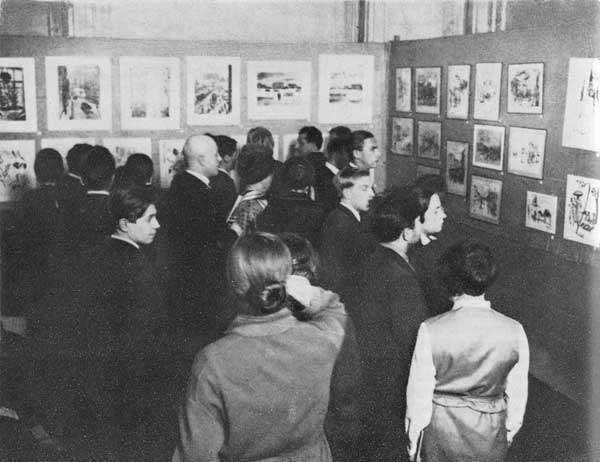
Opening of the first exhibition of the Thirteen group. 1929.
The first exhibition was held in in February 1929, at the House of Publishing, and it so happened that there were 13 participants. This led the artists to name it Thirteen, as well. The critics have noted the tightly knit group of young artists brought from ROST Society. They all have studied with great masters, such as R.R.Falk and A.V.Shevchenko.
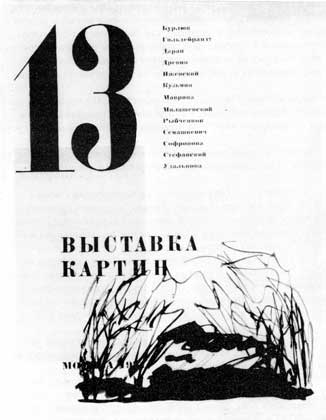
Catalogue cover for the third exhibition
of the Thirteen group. 1931.
It wasn't one of the largest, most widely known groups, either by number of its members or exhibition activity, such as AKhRR, or OST. Even compared to the smaller societies such as Makovetz, or 4 Arts Society, this group's place was rather unassuming. As its name suggests, the group was not large, and the time frame for its activity was not long. Nevertheless, the approach of these artists to drawing and painting was quite remarkable and remained true in their later life, as well. In fact, speaking about time, the group was has had no real time for existing and developing, since it was formed so late, and disbanded only after 2-3 years by the order to eliminate all artistic groupings, in 1932.
The Thirteen movement appeared primarily as a group of graphic artists, who have placed before them specific artistic principles in the drawing area. Looking at the rise of the graphic art of the time, a group of artists specializing in the specifics of drawing is a remarkable phenomenon, deserving a special place among other contemporary movements.
The first exhibition, held as was stated above, in 1929, has found favor in wide circles and the media. The newspaper "Gudok" has written: "These artists are working in an area of fine arts which has lately exhibited a sort of sluggishness, weariness, and even some cliche patterns. The work of all thirteen artists is valuable precisely for the fact that each strives to overcome these patterns in his own way, to find new ways or drawing, and this without any advertising or fashionable pose. The exhibition definitely presents a high standard of soviet drawing, surprising even for some of the experts".
However, the exhibition has also caused a great deal of arguments and clashes, including within the Thirteen movement, and several artists left the group during preparation of the second exhibition, which was canceled, as a result of the breakup. Among the artists who left were the Kashin sisters, Nedbailo and Rastorguyev.
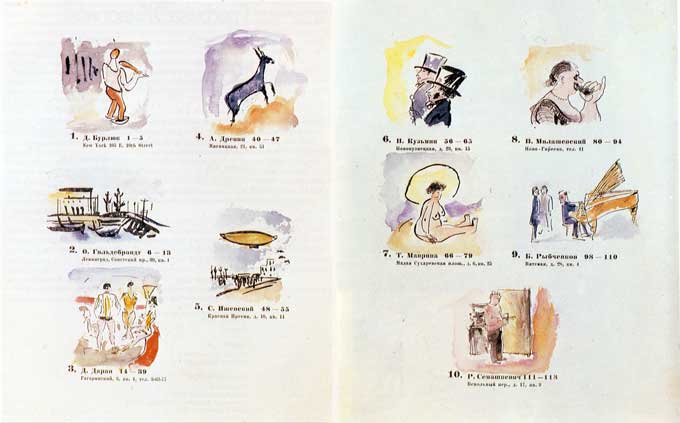
Doublespread from catalogue for the third exhibition of the Thirteen group. 1931.
The third exhibition was held in 1931, with several new names participating, such as Z.Liberman and R.Semashkevich. This last exhibition has also included works from some well-established artists: D.Burliuk, A.Drevin, A.Sofronova and N.Udaltzova.
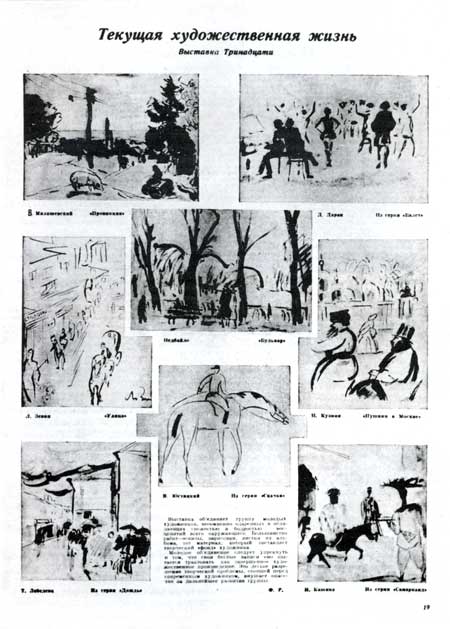
A page from the journal "Krasnaya niva"
with works of the Thirteen group members. 1929.
The group's direction and aim was first clearly formulated in the essay written by Kuzmin for the second exhibition and called "A conversation at an exhibition". It was a report of a argument held between Roginskaya on the one side and Kuzmin and Romov on the other, and discussed questions of highest importance to the artists. What may be considered a good drawing? Are a correct drawing and a good drawing one and the same?And where does the boundary pass between the strict expressiveness of a line and the obvious ineptitude or dilettantism? "In their works, like in letters to a close friend, the artists place the highest importance on honesty and abhor uniform of any sort: academic, cubist or any other". The artists stresses the importance of free drawing, based on unconstrained observation of nature.
As difficult as it would be to view I.Repin as any type of predecessors to the Thirteen movement, nevertheless many of its members have felt a sort of kinship with his later works. For example, Milashevsky directly compared in one of his essays the live drawing by Repin to the correct, over-made drawing by artists of the World of Art. Kuz'min stated on the subject of Repin's drawings: "Many of the Thirteen artists have known Repin's drawings and placed his drawing above Serov. His drawings 'Nevsky Boulevard', 'At Dominique' were well known and admired, creating a sense of closeness."
Selected works of the Thirteen members were noted and published in journals of the time: "Prozhector", "Krashaya niva" (Red Field) and others. The OST movement members were working in the same journals: Deineka, Lyushin, Pimenov and others. The comparison between the two groups was timely and well based, as both the Thirteen and OST were united in their interest for everything contemporary. However, the same comparison shows also the differences between the two groups in both the thematic and stylistic approach.
In a short essay, accompanying photos from the works of the Thirteen movement members in journal "Krasnaya niva" #6 from 1929, the critic Roginskaya wrote that these works are remarkable in their "freshness and newness of impression of the surroundings".
The third exhibition of the movement has brought very different response from the first, despite the appearance and obvious approval from A.Lunacharsky, the NARKOM of Education. The media reports have still noted the "high artistic quality" of the works, the "technical ability", the "fine canvases". But the reports, as a whole, were far from positive.
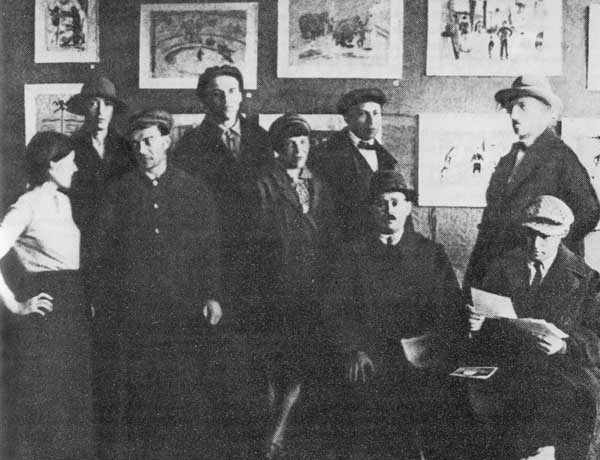
In the exposition hall at third exhibition of the Thirteen group. 1931.
"The exhibition may only be seen as a show of bourgeois artists consciously targeting the bourgeois audience", wrote R.Cherniak from "Komsomolskaya Pravda". This sort of criticism has received the classification of vulgar-sociological, and its injustice is keenly felt to this day. This type of criticism has had a heavy impact on the artists, both on their creative development and on their future lives. Soon after that the movement has ceased to exist.
